Milk Vs Water: Which Makes The Better Cup Of Hot Chocolate?

Hot cocoa and apple cider are two of the more iconic winter-season beverages. Both warm the body, even in the chilliest of winters, and for many families, both have a deep-seated history of holiday enjoyment during the winter season. There's no doubt that many of us remember coming in from making snowmen to a piping hot cup of hot chocolate laid before us with a plate of cookies. In contrast, others have fond memories of enjoying cocoa while watching movies in the final days of school before the winter holidays. Perhaps your connection to hot cocoa stems directly from the seminal classic, "The Polar Express," where the children were treated to hot cocoa while riding the train to the North Pole. Or perhaps you've been chasing that perfect cup of hot chocolate Judy shares in the original "Santa Claus."
No matter your connection, there's a good chance you've made hot cocoa before, and if you have, you may have encountered the same quandary we have found ourselves with: Does water or milk make better hot chocolate? On a mission to find out, and to avoid common hot chocolate mistakes, we conducted a blind taste test, comparing hot chocolate made with milk, water, and a combination of the two. While we weren't shocked by our results, we were surprised by just how delicious even our least favorite option was.
Read more: 31 Coffee Brands, Ranked From Worst To Best
Adding Milk Could Amplify Creaminess

When you think of making hot chocolate at home, there's a good chance your immediate process is to turn on the tap and warm up some water for your beverage. While this is a perfectly suitable option in most cases, consider opening your fridge and warming up a bit of milk, instead. This simple change can create an entirely new drinking experience.
Although hot chocolate doesn't necessarily need an even more creamy, decadent taste, using milk certainly enriches the experience. We suspect that milk adds a creamier taste than water alone, and when combined with the notes of chocolate, the smooth undertones of the milk simply add a delicious backdrop. In our taste test, we chose to use whole milk as our base, rather than 2% or skim. We felt this would offer the most significant difference in taste compared to hot chocolate made with just water, while still using simple milk rather than cream.
Using Water Is Easier

On the other hand, the simplicity of turning on the tap is undeniable. Using a tea kettle to warm up water can be a delightful part of creating a quiet, chocolatey, cozy moment. Plus, it's more economical. Using water from your home, as opposed to milk that you have to purchase, certainly makes for a more budget-friendly option, and if you're preparing hot chocolate for a crowd, using water makes the process that much simpler.
Additionally, there's an appeal to using water for its potential to create a truer hot chocolate experience. Milk, with its white base, can dilute the brown color of the hot chocolate. In contrast, water's clear base allows the cocoa to appear much darker. Furthermore, water enables the hot chocolate powder to melt seamlessly into the liquid, dissolving more easily than it might with milk. This often results in a less clumpy hot chocolate. This can make all the difference because, as we're learning with hot chocolate, flavor is important, but the texture is also a significant factor in perfecting that cup of cocoa.
Helpful Tools To Have On Hand
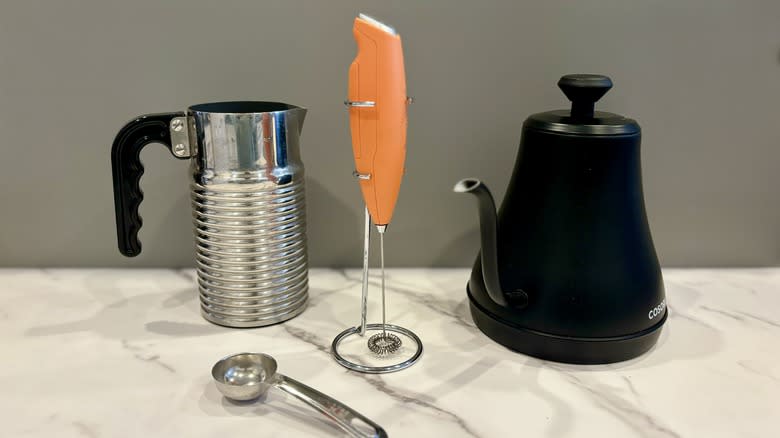
To make your hot chocolate, you can simply use a tablespoon scoop, and spoon, along with your chosen liquid. However, we like to elevate the experience a bit with a few handy tools.
We use our electric tea kettle to warm the water, a Nespresso milk frother to warm and froth the milk, and a small, electric whisk to mix everything together thoroughly. We find that the tea kettle and milk frother make for a more enjoyable experience than simply microwaving your liquid, and the electric whisk allows for full integration of the hot cocoa powder, regardless of whether we're using water or milk as our base. Of course, you're also going to need a measuring tool. Our Swiss Miss hot cocoa mix recommends 3 tablespoons of the powdery brown stuff for each cup, so we used a tablespoon measure to help us get just the right amount.
How We Make Our Hot Cocoa
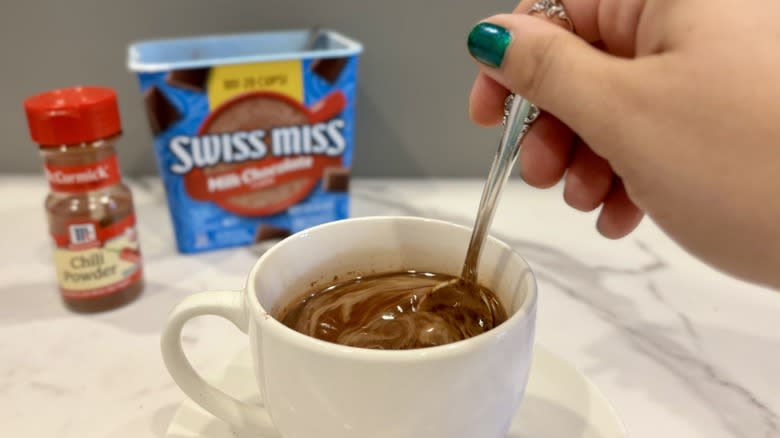
We always start by adding scoops of cocoa to the bottom of our cup. This technique ensures that when you pour your liquid on top, whether it's milk or water, the powder dissolves more easily. Adding cocoa on top of the liquid tends to create a clumpy mixture, prolonging the mixing process. We use our electric whisk, pressing the button a few times to thoroughly whisk everything. Then, we continue the mixing by hand using a spoon. If your mug is large enough, you can use exclusively the electric whisk to combine everything. However, since we wanted to use three identical mugs and the ones we had were slightly smaller, we couldn't use the electric whisk exclusively without risking a mess.
After preparing your hot cocoa base, there are other ways to make your hot chocolate even more special. Adding chili powder can give it a spicy kick that enhances the chocolate flavor. We also enjoy including special hot cocoa toppings to make the experience more festive and delightful. Stirring in hazelnut spread, a favorite pantry staple, would add a whole other taste and depth. During the holiday season, stirring your hot chocolate with a candy cane adds a festive touch, infusing it with a tasty and refreshing peppermint flavor.
Taste Test: Cocoa With Water
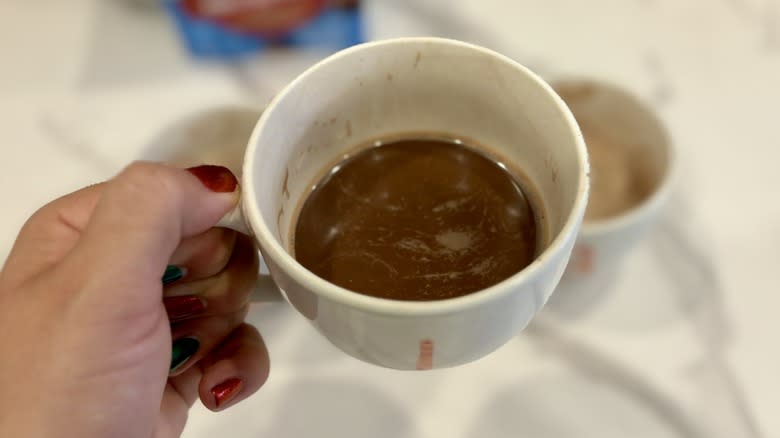
We conducted our blind taste test by first preparing our hot chocolate according to the directions, using a specific base for each mug. On the bottom of each cup, we marked which liquid was used so we could refer back after tasting. Then, to ensure a completely blind test, we turned our backs and had a fellow participant shuffle the mugs. We then numbered the cups and began sipping.
Mug No. 1, as it turned out, contained the cocoa mix with water. True to our suspicions, this hot chocolate was the darkest of the three and had the thinnest texture. The chocolate flavor came through strongly, and the Swiss Miss taste was quite delightful. We were also pleased to find that this cup of hot cocoa was virtually clump-free, with everything integrating well into the hot water. We had set our tea kettle to 170 F, which we believe was the perfect temperature for immediate drinking upon preparation, and it seemed ideal for this purpose.
Taste Test: Cocoa With A Combination Of Milk And Water
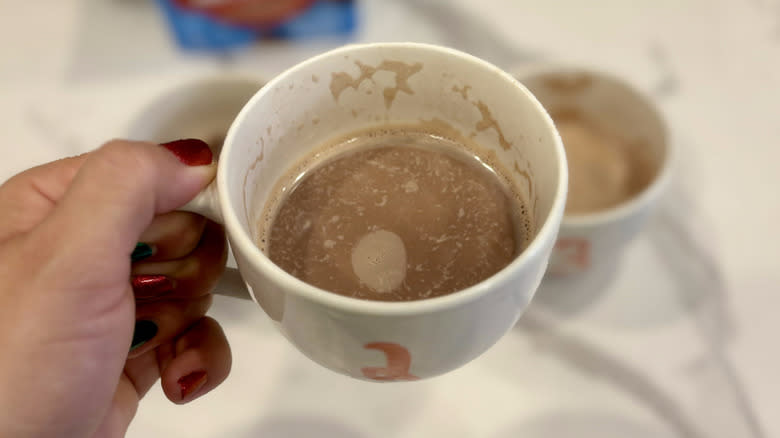
We thought it only fair to include a combination of cocoa with both water and milk in our comparison. For this method, we used the same 3 tablespoons of hot cocoa but mixed it with equal parts milk and water. The resulting drink had a medium brown color, which logically follows from the combination of the two liquids. It had a nice body to it, being a bit thicker than the water-based version, but not as thick as the milk-based one. This outcome makes sense, given the combination of the two.
Admittedly, the appearance of the milk and water coming together in this drink seemed a bit odd to us, even as we were preparing it. There's no real need to pursue this combination when making hot chocolate, and our experiment was purely for comparison purposes. We can't imagine a hot cocoa packet actually recommending the use of half water and half milk for the preparation of hot chocolate.
Taste Test: Cocoa With Milk

The third mug we sampled was the cocoa made with milk. We entered this trial anticipating that this would be smoother and richer than the hot chocolate made with water, but even with this expectation, we noticed a significant increase in both body and smoothness that shocked us in its change from the water.
This hot cocoa was the creamiest of the three, offering a richness and a luxurious feel that the others lacked. Interestingly, regardless of the type of liquid used, the Swiss Miss flavor came through nice and strong, even with the milk. The presence of milk didn't hinder the hot chocolate in any way, nor did it significantly amplify the flavor. While you might have anticipated flavor to be the biggest difference, the most notable difference was in the texture and relative thickness of the drink compared to the other two we had just sampled.
Verdict: Did We Prefer Milk Or Water Added?
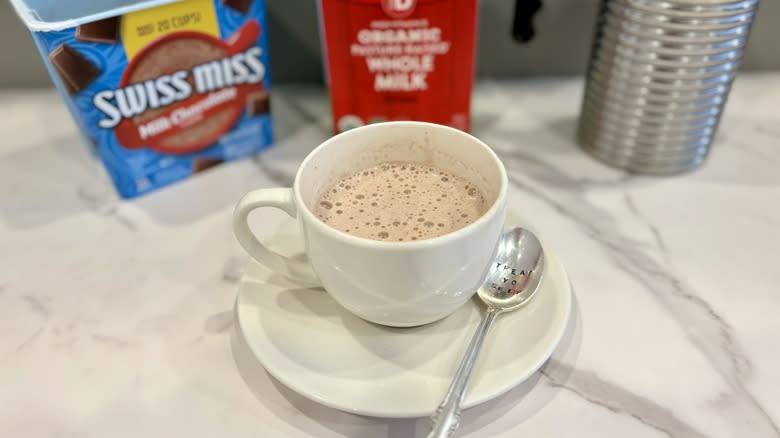
In terms of ranking, we agreed that the cocoa made with milk provided an ultra-smooth experience and was our favorite. However, we were pleasantly surprised by how much we enjoyed the water-based cocoa. While it wasn't as creamy as the milk, it had its benefits. If you're looking for something a bit less decadent, the water option would be perfect. Cocoa made with milk feels like something you'd enjoy while cozying up with a good book in front of a winter fire, while cocoa with water seems more like the hot chocolate you'd take on the go while holiday shopping or warming up at a chilly, outdoors, lighted Christmas parade. On the other hand, we found the combination cocoa to be a little on the strange side. It feels better to go fully water or fully milk than it does to sit somewhere in the middle.
We expected to have serious reservations about the cocoa with water but were thrilled to find that it held up well, even in comparison to the milk-based cocoa. Our verdict is that most of the time, we'd probably prefer cocoa with milk, but we can see situations where cocoa with water would be more suitable. With all of this said, we highly recommend reading the package directions on your cocoa. Some packages specify to add water, while others say to add milk, and these recommendations can make a world of difference in your cocoa.
Read the original article on Tasting Table.

 Yahoo Finance
Yahoo Finance 